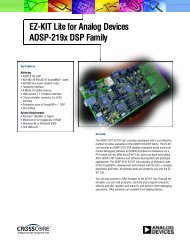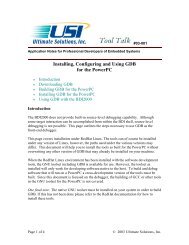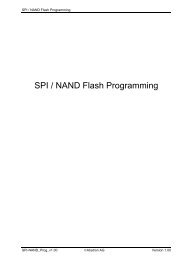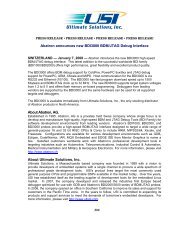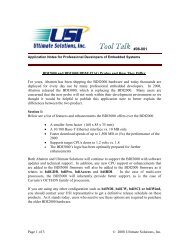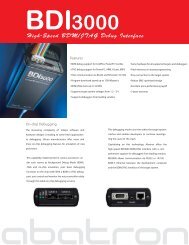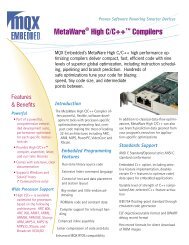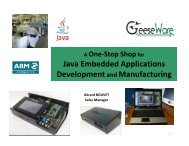STM32 Journal - Digikey
STM32 Journal - Digikey
STM32 Journal - Digikey
Create successful ePaper yourself
Turn your PDF publications into a flip-book with our unique Google optimized e-Paper software.
<strong>STM32</strong> <strong>Journal</strong><br />
Window comparator<br />
configuration switch<br />
Figure 5 Developers can use the integrated comparators to create a power-efficient analog<br />
watchdog that monitors an input and wakes the <strong>STM32</strong> L1 when either the upper or<br />
lower threshold is exceeded.<br />
CPU running at<br />
Input voltage<br />
Upper threshold:<br />
V REFINT<br />
= 1.22V<br />
Lower threshold:<br />
Multiple source<br />
COMP1<br />
–<br />
+<br />
COMP2<br />
+<br />
–<br />
ADC current consumption (in µA)<br />
(ADC in continuous mode, delay of 15 cycles between channel<br />
conversions, conversions last 1µs (16 cycles at 16MHz)<br />
ADC is running<br />
in Normal Mode **<br />
ADC is On<br />
in Power Saving Mode***<br />
16MHz (from HSI) 1453µA 630µA<br />
4MHz (from MSI)* 1453µA 445µA<br />
1MHz (from MSI)* 1000µA 258µA<br />
32kHz (from MSI)* 900µA 150µA<br />
* : HSI is On ** : PDI=PDD=0 *** : PDI=PDD=1<br />
Figure 6 The automatic shut down mode of the <strong>STM32</strong> L1 turns off the ADC for the majority of<br />
time between samples to provide dramatic savings in power consumption compared<br />
to when the ADC must be left on continuously.<br />
power down the ADC between<br />
samples. Consider an ECG<br />
monitor where the sampling rate<br />
is 1 KHz or one sample every 1<br />
ms. The ADC of the <strong>STM32</strong> L1<br />
consumes at most 900 µA and<br />
has a capture time of only 1 µs<br />
for a power duty cycle of 0.1%.<br />
If the <strong>STM32</strong> L1 were a typical<br />
MCU, the ADC would consume<br />
full power even when it is not<br />
capturing samples. Thus, if<br />
the system were using a 1 ms<br />
measurement window, the ADC<br />
would draw 900 µA during a<br />
power duty cycle of 100%.<br />
With the automatic power down<br />
control mode of the <strong>STM32</strong><br />
L1, however, the ADC is able<br />
to power down for the majority<br />
of time between samples.<br />
Figure 6 shows actual power<br />
consumption numbers for<br />
various operating conditions. The<br />
difference in power consumption<br />
is dramatic between when the<br />
ADC is left on continuously<br />
versus using automatic power<br />
down control saving mode,<br />
dropping in the lowest power<br />
consumption example from 900<br />
µA to 150 µA at 32 kHz.<br />
Note that the <strong>STM32</strong> L1 has<br />
the flexibility to scale the CPU<br />
clock while keeping a constant<br />
16 MHz clock available for ADC<br />
conversion. This means that the<br />
CPU can run at a frequency of 32<br />
kHz while the ADC maintains a 1<br />
MSPS sampling rate while only<br />
drawing 150 µA.<br />
Precision Analog<br />
Many medical applications require<br />
the ability to read very small<br />
signals. For example, an ECG<br />
monitor has to capture the very<br />
small electrical signal generated by<br />
the heart muscle while removing<br />
the 50 or 60 Hz noise signals<br />
that are common in electrodes<br />
attached to the human body.<br />
MCUs typically offer an 8- or 10-<br />
bit ADC. With its 12-bit ADCs,<br />
<strong>STM32</strong> MCUs enable developers<br />
to achieve greater precision when<br />
measuring the weak signals<br />
typical of the human body. In<br />
addition, with sample rates up to<br />
1 Msample/second, developers<br />
have the headroom to access<br />
even more accuracy through<br />
oversampling. This enables<br />
devices to operate in noisy<br />
environments and applications<br />
that could not be served by an<br />
MCU with only an 8-bit ADC.<br />
Power-Efficient<br />
Communications<br />
The <strong>STM32</strong> architecture offers<br />
a wide range of interfaces,<br />
31




